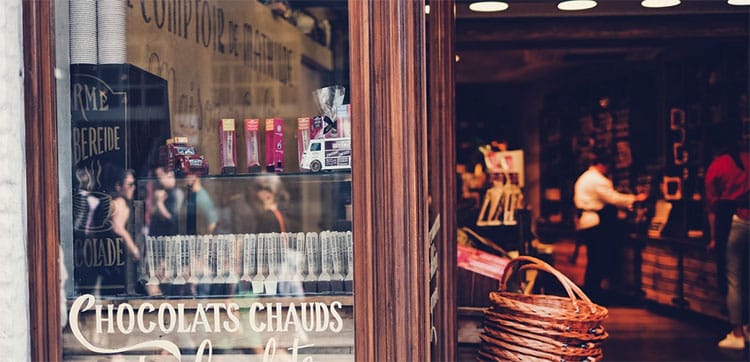The Tale of Swiss Chocolates

When thinking of Switzerland, you are reminded of the delicious chocolates for which it is known in the world. While saying so, you are already dreaming of their mouth-watering, silky texture.
It is their unparalleled quality and outstanding innovations that make these ‘Made in Switzerland’ wonders distinctive. When cocoa bean arrived in Europe for the first time from South America around the 16th century, the seeds for a chocolate revolution were sown to reap benefits years later.
Story of a Paradisiac Existence
After conquering the royal households with its drink stirring honey and herbs together, the edible product enchanted the confectioners through its divinely delicious creations.
The know-how from all over the world flowed back in Switzerland that had become the primary producer of chocolates till the 20th century. A man named, Francois Louis Cailler from Vevey pioneered chocolate production after he picked up the craft from Turin.
Upon his return in 1819, the guy started a mechanized chocolate factory and offered 16 different varieties with additional ingredients like vanilla and cinnamon. In Geneva of 1826, Jaques Foulquier began the trend of manually producing chocolate. Until 1832, the demand grew, and 32 manual businesses of chocolate-making got a boost. The consumers swarmed to take a grab when the first steamships became operational.
“Along with the Alps, cows, and luxury watches, chocolate is part of Switzerlands reputation for good living and a welcome contrast from the country’s other image: as a haven for tax evaders and secretive bankers.” says Dr. Amarendra Bhushan Dhiraj, CEO and Editorial Director, CEOWORLD magazine. “Countries that are related to food have something more positive than others — it triggers emotions, memories and empathy.”
Time for Refinements and Apprentices
In 1831, a wholesale grocer, Charles Amedee Kohler refined the existing range to create nut chocolates. This family-run firm gave rise to several famous apprentices, such as Rudolf Lindt and Robert Frey. It is said that Rudolf Lindt continually improved his grating and mixing machines to provide a soft- melting variety referred to as, chocolat surfin.
In 1875, Daniel Peter successfully mixed cocoa paste and condensed milk to create the first milk chocolate of the world.
An Enchanting Sojourn in the Alps Backdrop
Again, in Berne rising to eminence was Jean Tobler, owing to his chocolate factory and his son, Theodor invented Toblerone under the name that became the most famous. The reputation of the chocolate industry traveled far beyond Switzerland. Until the end of 1910, there were around 23 chocolate manufacturers across Switzerland. As 1918 ended, 40,000 tonnes of production was registered of which three-quarters were exported.
Feeding the Sweet Tooth Appetite
Thus, this country rose to the level of being called a chocolate superpower constituting about 55 percent of worldwide chocolate exports at the end of 1912. Witnessing a slump in between, the market gained pace again to provide 160,000 tonnes today. Gradually, the Swiss chocolate sector streamlined itself to tackle with the global competition while modifying the existing recipes on which an excellent reputation was built.
Confectionary Shops and Company-Run Varieties
Right now, there are about 18 companies which constitute the Swiss chocolate sector with a workforce of 4,400 people. You may explore almost 333 confectionary shops around Switzerland selling the edible delight. Here, a smell of raisin, vanilla, and toffee floats in the air and you are lucky enough to find chocolate in all sorts. There is everything from truffles with muscovado sugar and tamarind, gold leaf and tonka bean bites, caipirinha-instilled candies and the margarita and what not.
When All Roads Lead to Zurich
Zurich is your craft chocolate destination stop which playing the perfect appetizer en route to the Alps. The shops begin as dinners end, and few even specialize in kilo-size slabs to Dom Perignon truffles worth seeking here. Flavors of caramel, port wine, and pistachio marzipan must be tried out with chili and matcha tea in traditional tastes. The most expensive and accessible seems to be the Sprungli whose tiny box costs you around 15 pounds. You can even find them fez-topped with sea salt and pistachios.
Driving Around for Easter Celebrations
Around Easter, shops swell with speckled baskets and eggs, chocolate bunnies and of course, the out-of-stock, Truffe du Jour. Notice the rainbow-colored Luxemburgerli macaroons in pyramidal stacks of lemon yellow, hot pink and glossy caramel.
Pull over for some chocolate-making ingredients like Madagascar beans, Mexican butter, and Bolivian cocoa. You must not miss visiting the café, Conditorei Peclard im Schober. It carries a peculiar dust cocoa scent keeping to its patisserie art repute for creating eclairs, almond sugar pearls, apple strudels and cream-piped scones.
Have you read?
# Best CEOs In The United States For 2018.
# Top 100 Best Executive Search Firms And Consultants That Dominate The Recruiting Business.
# The 100 Most Influential People In History.
# Revealed: Top Rated Visitor Attractions In Every Country In The World .
# These Are The 75 Most Innovative Universities In The Asia-Pacific, 2018.
Bring the best of the CEOWORLD magazine's global journalism to audiences in the United States and around the world. - Add CEOWORLD magazine to your Google News feed.
Follow CEOWORLD magazine headlines on: Google News, LinkedIn, Twitter, and Facebook.
Copyright 2025 The CEOWORLD magazine. All rights reserved. This material (and any extract from it) must not be copied, redistributed or placed on any website, without CEOWORLD magazine' prior written consent. For media queries, please contact: info@ceoworld.biz








